Download Files
Enter your PIN to download your secret files.
----
Search out the password in the image

a,c,e,h,k,r,z}) = hackerzNew York Times, March 12 2015 An Easter Egg of the famous Hacky Easter white-hat hacking competition, was leaked last Tuesday by the famous hacker group "Bunnonymous". Experts confirmed its authenticity, but could not crack the code hidden it in yet. Can you do better?
img, but = HTML table@mediastyle: class='h5' styled differently when page is printed…
.x5 { height: 4%; width: 4%; background: #fff;}
@media print {
…
.x5 { height: 4%; width: 4%; background: #000;}
}You intercepted a message sent by a nerd from the office nearby. On first sight, there's nothing suspicious in it. However, you are almost sure that something secret must be hidden in it. Can you find out what? legostego.lxf
.lxf ‐ open-with: LEGO Digital Designer

/assets/www/challenge04.html:
Calculate/convert the following values, and sort them in ascending order
|
|
xs = [1400,9671406559999999577423872,299792458,2130706433,36.4621596072,2147483647,13631488,1048576,50,36,100000,261.626]sorted(zip(xs,xrange(1,len(xs)+1)))map(lambda (x,y): y, sorted(zip(xs,xrange(1,len(xs)+1))))var h = "10,5,9,12,1,11,8,7,3,4,6,2";for (var i=0; i<10000; i++) {h = CryptoJS.SHA1(h);} decryptScrambledEggWithKey('' + h);…In this challenge, you need to play with your phone a bit. Try to find out what controls the four bars, and make them reach the full width (all at the same time).
/assets/www/challenge05.html:requestLevels is invoked every 1000ms to query ps://sensors endptsensorFeedback(json) sets lvls by parsing JSON response vars {l1,l2,l3,l4,k}…
function requestLevels() {
window.location.href="ps://sensors";
}
function sensorFeedback(json) {
var jsonResp = JSON.parse(json);
setLevel(1, jsonResp.l1);
setLevel(2, jsonResp.l2);
setLevel(3, jsonResp.l3);
setLevel(4, jsonResp.l4);
if (jsonResp.k) {
decryptScrambledEggWithKey(jsonResp.k);
clearInterval(intervalId);
}
}
var intervalId = setInterval(requestLevels, 1000);
…
ps://sensors is mentioned @/src/ps/hacking/hackyeaster/android/c.java…
if ("ps://sensors".equals(s))
{
Activity.e(a);
return true;
}
…
static e(Activity a) is defined @ /src/ps/hacking/hackyeaster/android/Activity.javaprivate SensorManager g;
…
static void e(Activity activity)
{
activity.d();
}
private void d()
{
h = g.getDefaultSensor(1); //TYPE_ACCELEROMETER
i = g.getDefaultSensor(2); //TYPE_MAGNETIC_FIELD
g.registerListener(this, h, 0);
g.registerListener(this, i, 0);
…
}
public int c()
{
Intent intent = registerReceiver(null, new IntentFilter("android.intent.action.BATTERY_CHANGED")); //current battery level
int i1 = intent.getIntExtra("level", -1);
int j1 = intent.getIntExtra("scale", -1);
if (i1 == -1 || j1 == -1)
{
return 50;
} else
{
return Math.round((i1 * 100) / j1); // to %
}
}
private void j()
{
int i1 = 100;
if (l == null || m == null) goto _L2; else goto _L1
_L1:
float af[] = new float[9];
if (!SensorManager.getRotationMatrix(af, new float[9], l, m)) goto _L2; else goto _L3
_L3:
float af1[] = new float[3];
SensorManager.getOrientation(af, af1);
int j1 = 5 * (int)Math.ceil((double)((int)(System.currentTimeMillis() / 1000L) % 100) / 5D);
int k1 = Math.round(100F * (Math.abs(af1[1]) + Math.abs(af1[2])));
int l1;
int i2;
int j2;
int k2;
String s;
String s1;
MessageDigest messagedigest;
String s2;
if (k1 <= 20)
{
l1 = i1;
} else
if (k1 > 300)
{
l1 = 0;
} else
{
l1 = Math.round((100 * (300 - k1)) / 280);
}
i2 = Math.round(100F * Math.abs(af1[0]));
if (i2 <= 20)
{
j2 = i1;
} else
{
j2 = 0;
if (i2 <= 300)
{
j2 = Math.round((100 * (300 - i2)) / 280);
}
}
k2 = c();
Exception exception;
if (k2 < 95)
{
i1 = k2;
}
s = "";
if (i1 + (j2 + (j1 + l1)) != 400)
{
break MISSING_BLOCK_LABEL_246;
}
s1 = (new StringBuilder(String.valueOf(j1))).append("f").append(l1).append("u").append(j2).append("n").append(i1).toString();
messagedigest = MessageDigest.getInstance("SHA1");
messagedigest.update(s1.getBytes());
s2 = Base64.encodeToString(messagedigest.digest(), 2);
s = s2;
_L5:
a.loadUrl((new StringBuilder("javascript:sensorFeedback('{\"k\": \"")).append(s).append("\", \"l1\": ").append(j1).append(", \"l2\": ").append(l1).append(", \"l3\": ").append(j2).append(", \"l4\": ").append(i1).append("}')").toString());
l = null;
m = null;
_L2:
return;
exception;
if (true) goto _L5; else goto _L4
_L4:
}
public void onSensorChanged(SensorEvent sensorevent)
{
if (sensorevent.sensor.getType() == 1) //TYPE_ACCELEROMETER
{
l = sensorevent.values;
g.unregisterListener(this, h);
h = null;
}
if (sensorevent.sensor.getType() == 2) //TYPE_MAGNETIC_FIELD
{
m = sensorevent.values;
g.unregisterListener(this, i);
i = null;
}
j();
}
…
Activity: e(a) → d() → callback-onSensorChanged() → j() → c() → retsensorFeedback({k: s, l1: j1, l2: l1, l3: j2, l4: i1}), where:s = base64(SHA1(j1+"f"+l1+"u"+j2+"n"+i1))Current timeAccelerometerCompassBattery percentage
The Doc's in trouble again, and you must come to his rescue! As you jump into his time machine, you realize that a password is needed to start it. Just in that moment of despair, you receive an audio message from the Doc, through space and time:
dah-dah-dit dit dah-dah-dah di-dah-dit dah-dah-dit dit dah-dah dah-di-dah-dit di-di-dah-dit di-dah-di-dit dah-di-dah-dah
#!/usr/bin/env python
import sys
import codecs
if __name__ == "__main__":
morse_lookup = {"dah": "T", "dah-dah": "M", "dah-dah-dah": "O", "dah-dah-dit": "G", "dah-dah-dit-dah": "Q", "dah-dah-dit-dit": "Z", "dah-dit": "N", "dah-dit-dah": "K", "dah-di-dah-dah": "Y", "dah-di-dah-dit": "C", "dah-dit-dit": "D", "dah-dit-dit-dah": "X", "dah-dit-dit-dit": "B", "dit": "E", "dit-dah": "A", "dit-dah-dah": "W", "dit-dah-dah-dah": "J", "dit-dah-dah-dit": "P", "di-dah-dit": "R", "di-dah-di-dit": "L", "dit-dit": "I", "dit-dit-dah": "U", "di-di-dah-dit": "F", "dit-dit-dit": "S", "dit-dit-dit-dah": "V", "dit-dit-dit-dit": "H"}
ms = "dah-dah-dit dit dah-dah-dah di-dah-dit dah-dah-dit dit dah-dah dah-di-dah-dit di-di-dah-dit di-dah-di-dit dah-di-dah-dah"
print "".join(morse_lookup[m] for m in ms.split()).lower()
georgemcflygeorgemcfly into Egg-O-Matic performs a HTTP GET request to http://hackyeaster.hacking-lab.com/hackyeaster/time?m=4&k=georgemcfly
m, according to given hint in img, by +3 ie. m=7curl -sL "http://hackyeaster.hacking-lab.com/hackyeaster/time?m=7&k=georgemcfly" | jq -r '.egg' | base64 -d
This egg is hidden in a street-view like viewer. Peek around the area and find it!
ps://panorama endpt/res/raw/quito2_u.jpgThis egg is hidden within an online spreadsheet. Go find it's URL, and extract the egg out of it. Spreadsheet ID:1QPkfrnSVRAhQKL7AZx_HVXWrRXDvwCnVX2ih0jYp1CA
| 0 | 19 | 3 | 22 | 4 | 11 | 20 | 6 | 1 | 9 | 25 | 10 | 23 | 5 | 12 | 13 | 7 | 15 | 16 | 17 | 18 | 14 | 21 | 8 | 2 | 24 |
|---|---|---|---|---|---|---|---|---|---|---|---|---|---|---|---|---|---|---|---|---|---|---|---|---|---|
| 3 | 1 | 1 | 1 | 1 | 1 | 0 | 0 | 1 | 0 | 1 | 1 | 1 | 1 | 1 | 0 | 1 | 1 | 0 | 1 | 0 | 0 | 1 | 0 | 0 | 0 |
| 19 | 1 | 1 | 0 | 1 | 0 | 0 | 1 | 1 | 1 | 1 | 1 | 0 | 1 | 1 | 1 | 1 | 0 | 0 | 1 | 0 | 0 | 1 | 0 | 1 | 1 |
| 10 | 0 | 1 | 0 | 1 | 0 | 1 | 0 | 1 | 0 | 0 | 1 | 0 | 0 | 0 | 0 | 0 | 1 | 0 | 1 | 0 | 0 | 0 | 0 | 0 | 0 |
| 1 | 1 | 1 | 1 | 1 | 0 | 1 | 1 | 1 | 0 | 1 | 1 | 1 | 1 | 0 | 0 | 1 | 1 | 1 | 1 | 0 | 0 | 1 | 0 | 1 | 1 |
| 21 | 1 | 1 | 1 | 1 | 1 | 1 | 0 | 1 | 1 | 1 | 1 | 1 | 1 | 1 | 0 | 1 | 0 | 1 | 1 | 1 | 0 | 1 | 0 | 0 | 1 |
| 22 | 1 | 1 | 0 | 1 | 1 | 0 | 0 | 1 | 1 | 1 | 0 | 0 | 1 | 0 | 1 | 1 | 1 | 1 | 1 | 1 | 1 | 0 | 0 | 0 | 1 |
| 8 | 0 | 0 | 0 | 0 | 0 | 0 | 0 | 0 | 0 | 0 | 0 | 0 | 0 | 0 | 1 | 0 | 0 | 1 | 1 | 0 | 0 | 0 | 0 | 0 | 0 |
| 16 | 0 | 1 | 0 | 0 | 1 | 1 | 0 | 1 | 1 | 0 | 0 | 0 | 0 | 0 | 1 | 0 | 0 | 1 | 1 | 1 | 1 | 1 | 0 | 0 | 0 |
| 4 | 1 | 1 | 1 | 1 | 0 | 0 | 0 | 1 | 1 | 1 | 1 | 1 | 1 | 1 | 0 | 1 | 0 | 1 | 1 | 0 | 1 | 1 | 0 | 0 | 0 |
| 2 | 1 | 0 | 0 | 0 | 0 | 0 | 0 | 1 | 1 | 1 | 1 | 0 | 0 | 1 | 1 | 1 | 0 | 1 | 0 | 0 | 0 | 0 | 0 | 0 | 0 |
| 12 | 0 | 1 | 0 | 1 | 1 | 0 | 0 | 1 | 0 | 0 | 1 | 0 | 0 | 1 | 0 | 0 | 1 | 1 | 1 | 1 | 0 | 0 | 0 | 0 | 0 |
| 11 | 1 | 0 | 0 | 0 | 0 | 0 | 0 | 1 | 0 | 1 | 1 | 1 | 1 | 1 | 1 | 1 | 0 | 1 | 0 | 0 | 1 | 1 | 1 | 1 | 1 |
| 25 | 0 | 1 | 1 | 1 | 0 | 1 | 1 | 1 | 1 | 1 | 0 | 0 | 1 | 0 | 1 | 1 | 1 | 0 | 0 | 0 | 0 | 1 | 0 | 1 | 1 |
| 24 | 0 | 0 | 0 | 0 | 0 | 1 | 0 | 1 | 1 | 1 | 0 | 0 | 0 | 0 | 1 | 1 | 0 | 0 | 0 | 1 | 1 | 1 | 0 | 0 | 0 |
| 7 | 1 | 1 | 1 | 1 | 1 | 1 | 1 | 1 | 1 | 1 | 0 | 1 | 1 | 0 | 1 | 1 | 1 | 0 | 1 | 0 | 0 | 1 | 0 | 1 | 1 |
| 20 | 0 | 0 | 0 | 0 | 1 | 0 | 0 | 1 | 0 | 1 | 0 | 0 | 0 | 1 | 0 | 1 | 1 | 0 | 1 | 0 | 0 | 1 | 0 | 0 | 0 |
| 5 | 1 | 1 | 1 | 1 | 1 | 0 | 0 | 1 | 0 | 1 | 0 | 1 | 1 | 0 | 1 | 1 | 1 | 0 | 1 | 0 | 0 | 1 | 0 | 0 | 0 |
| 18 | 0 | 0 | 1 | 0 | 1 | 0 | 0 | 0 | 1 | 1 | 1 | 1 | 0 | 0 | 0 | 0 | 0 | 1 | 1 | 0 | 0 | 1 | 0 | 0 | 0 |
| 14 | 1 | 0 | 1 | 1 | 1 | 1 | 1 | 1 | 0 | 0 | 1 | 1 | 0 | 0 | 1 | 0 | 0 | 1 | 1 | 1 | 1 | 0 | 1 | 1 | 1 |
| 13 | 1 | 0 | 0 | 0 | 0 | 1 | 0 | 1 | 0 | 1 | 1 | 0 | 1 | 1 | 0 | 1 | 0 | 1 | 0 | 1 | 0 | 1 | 1 | 0 | 1 |
| 17 | 1 | 1 | 0 | 0 | 1 | 1 | 1 | 1 | 1 | 1 | 1 | 0 | 1 | 0 | 1 | 1 | 1 | 0 | 1 | 1 | 0 | 1 | 0 | 0 | 0 |
| 23 | 0 | 1 | 1 | 1 | 0 | 1 | 0 | 1 | 1 | 1 | 1 | 0 | 1 | 0 | 0 | 1 | 1 | 1 | 0 | 0 | 1 | 0 | 0 | 0 | 0 |
| 15 | 1 | 0 | 1 | 1 | 1 | 0 | 0 | 1 | 0 | 1 | 0 | 1 | 1 | 0 | 0 | 1 | 1 | 1 | 0 | 0 | 1 | 1 | 0 | 0 | 0 |
| 6 | 1 | 0 | 0 | 0 | 1 | 0 | 0 | 1 | 1 | 1 | 0 | 0 | 0 | 0 | 0 | 1 | 0 | 1 | 0 | 0 | 0 | 0 | 0 | 0 | 0 |
| 9 | 0 | 1 | 1 | 1 | 1 | 1 | 0 | 1 | 1 | 0 | 1 | 0 | 1 | 0 | 1 | 1 | 0 | 0 | 0 | 1 | 1 | 0 | 1 | 1 | 1 |
lvl08-grid.txt#!/usr/bin/env python
#-*- coding: utf-8 -*-
import sys
import codecs
from PIL import Image
sys.stdout = codecs.getwriter("utf8")(sys.stdout)
sys.stderr = codecs.getwriter("utf8")(sys.stderr)
def parse(filepath):
row_idx, col_idx, grid = [], [], []
with codecs.open(filepath, "r", "utf-8") as f:
for i, line in enumerate(f):
line = line.strip()
if not line: continue
if i == 0:
col_idx = map(int, line.split("\t"))[1:]
col_idx = map(lambda i: i-1, col_idx)
length = len(col_idx)
grid = [[0 for x in xrange(length)] for x in xrange(length)]
else:
toks = map(int, line.split("\t"))
row_idx.append(toks[0]-1)
toks = toks[1:]
for j in xrange(length):
grid[i-1][j] = toks[j]
grid_tmp = [[0 for x in xrange(length)] for x in xrange(length)]
for i,c in enumerate(col_idx):
for j in xrange(length):
grid_tmp[j][c] = grid[j][i]
for i,r in enumerate(row_idx):
for j in xrange(length):
grid[r][j] = grid_tmp[i][j]
# for i in xrange(length):
# for j in xrange(length):
# print>>sys.stderr, str(grid[i][j])+"\t",
# print>>sys.stderr
return grid
def enlarge(grid):
length = len(grid)
if length > 0: length = min(length, len(grid[0]))
grid_large = [[0 for x in xrange(length*length)] for x in xrange(length*length)]
for i in xrange(length):
for j in xrange(length):
for x in xrange(length):
for y in xrange(length):
grid_large[i*length+x][j*length+y] = grid[i][j]
return grid_large
def save(grid, outfile):
length = len(grid)
if length > 0: length = min(length, len(grid[0]))
im1 = Image.new("RGB", (length,length))
pix1 = im1.load()
w, h = im1.size
for i in xrange(h):
for j in xrange(w):
pix1[j,i] = tuple([(1-grid[i][j])*255]*3)
im1.save(outfile, outfile.split(".")[-1].upper())
return im1
if __name__ == "__main__":
grid = parse("lvl08-grid.txt")
grid = enlarge(grid)
save(grid, "lvl08-grid.png")
Egg number nine is hidden here in the app. You've already seen it, haven't you? Go catch it and squint like a fish.
/res/drawable/id_launcher.pngIn order to get this egg, you need to search on the web site. Rumors say that Thumper himself has bagged it.
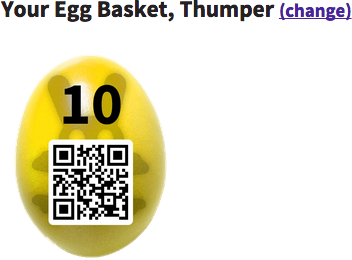
You caught a Thunderbird mail box, which contains an easter egg. Go find it! Mail.zip
Inbox, search for attachment:"signature.zip"signature.zip via its base64-encodingpbpaste | base64 -d >signature.zipunzip -l signature.zipArchive: signature.zip
Length Date Time Name
--------- ---------- ----- ----
64915 09-17-2014 20:20 egg_11.png
--------- -------
64915 1 file
<button type="submit" name="success" value="false">Submit Test</button>
curl -sL -X POST "http://hackyeaster.hacking-lab.com/hackyeaster/ceh" -d "q1=nmap&q2=revocation&q3=4950&q4=384&q4=512&q5=88&success=true" returns:…
Congratulations, you passed!!!
<div class="eggImage" style="background-image: url('./images/egg_12_an8snbui1FeLO3Ugw89N.png')"></div>
…
wget "http://hackyeaster.hacking-lab.com/hackyeaster/images/egg_12_an8snbui1FeLO3Ugw89N.png"Welcome to Leet TV! Click the image below to play our trailer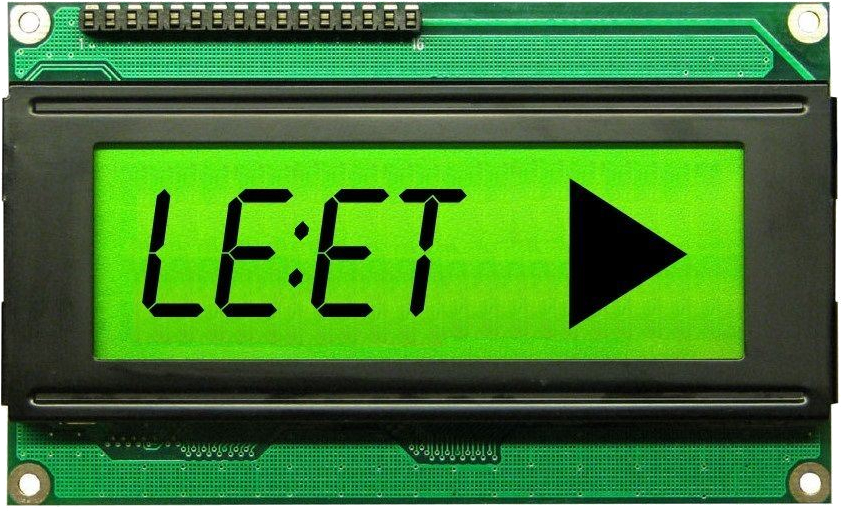
ffmpeg -i file/leettv.mp4 -vf fps=30 leettv@%d.pngzbarimg -q leettv@[0-9]*.png | sed 's|^QR-Code:||g' | sort | uniq >>leettv-qrcode.lstexiftool leettv_qbEtJZKLTLB3jByIWSpE.wavTitle : The Hint
Comment: siht esrever ot yrt
echo -ne "siht esrever ot yrt" | rev says "try to reverse this"sox leettv_qbEtJZKLTLB3jByIWSpE.wav leettv_qbEtJZKLTLB3jByIWSpE-rev.wav reverseeight forty-twoffmpeg -i file/leettv.mp4 -ss 00:08:42.001 -vframes 1 leettv@0842.png
Wise Rabbit says: An egg I give you for free, it's below, as you can see. But something got lost add a dimension you must!
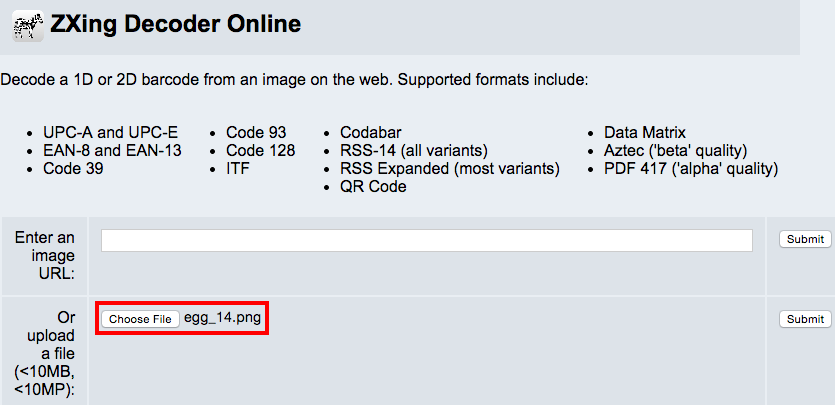
egg_14.png to QR code decoder
yckgKB2iV1rvNEfCoNiRYour gallery needs some nice easter snapshots! What about a nice grasslands panorama, or a still life of a tomato?

/src/ps/hacking/hackyeaster/android/Activity.java…
protected void onActivityResult(int i1, int j1, Intent intent)
{
super.onActivityResult(i1, j1, intent);
if (i1 != 1336) goto _L2; else goto _L1
_L1:
f = false;
if (j1 != -1 || intent == null || !"ps.hacking.zxing.client.android.SCAN".equals(intent.getAction())) goto _L4; else goto _L3
_L3:
a(intent);
_L6:
return;
_L4:
a(2, "");
return;
_L2:
if (i1 != 1337) goto _L6; else goto _L5
_L5:
File file;
file = new File(Environment.getExternalStorageDirectory(), "HackyEaster");
if (!file.exists() && !file.mkdirs())
{
Toast.makeText(this, "Couldn't create folder on sdcard.", 0).show();
}
if (!file.exists() || intent == null || intent.getExtras() == null) goto _L6; else goto _L7
_L7:
File file1;
Bitmap bitmap;
Bitmap bitmap1;
Canvas canvas;
int k1;
int l1;
long l2;
long l3;
long l4;
int i2;
file1 = new File(file, (new StringBuilder("Snapshot_")).append(e.nextInt()).append(".png").toString());
bitmap = (Bitmap)intent.getExtras().get("data");
bitmap1 = bitmap.copy(android.graphics.Bitmap.Config.ARGB_8888, true);
canvas = new Canvas(bitmap1);
k1 = bitmap.getHeight();
l1 = bitmap.getWidth();
l2 = 0L;
l3 = 0L;
l4 = 0L;
i2 = 0;
_L8:
if (i2 >= l1)
{
int j2;
int k2;
String as[];
if (k1 > l1 && (double)l2 > 0.90000000000000002D * (double)(l3 + l4))
{
byte abyte2[] = Base64.decode(Base64.decode(j, 0), 0);
Bitmap bitmap4 = BitmapFactory.decodeByteArray(abyte2, 0, abyte2.length);
int k3 = bitmap4.getHeight();
canvas.drawBitmap(bitmap4, (l1 - bitmap4.getWidth()) / 2, k1 - k3 / 2, null);
} else
if (l1 > k1 && (double)l3 > 0.90000000000000002D * (double)(l4 + l2))
{
byte abyte1[] = Base64.decode(Base64.decode(j, 0), 0);
Bitmap bitmap3 = BitmapFactory.decodeByteArray(abyte1, 0, abyte1.length);
int j3 = bitmap3.getHeight();
canvas.drawBitmap(bitmap3, (l1 - bitmap3.getWidth()) / 2, -j3 / 2, null);
} else
{
byte abyte0[] = Base64.decode(k, 0);
Bitmap bitmap2 = BitmapFactory.decodeByteArray(abyte0, 0, abyte0.length);
int i3 = bitmap2.getHeight();
canvas.drawBitmap(bitmap2, (l1 - bitmap2.getWidth()) / 2, (k1 - i3) / 2, null);
}
try
{
FileOutputStream fileoutputstream = new FileOutputStream(file1);
bitmap1.compress(android.graphics.Bitmap.CompressFormat.PNG, 100, fileoutputstream);
fileoutputstream.flush();
fileoutputstream.close();
}
catch (Exception exception) { }
as = new String[1];
as[0] = file1.toString();
MediaScannerConnection.scanFile(this, as, null, new e(this));
return;
}
j2 = 0;
label0:
{
if (j2 < k1)
{
break label0;
}
i2++;
}
goto _L8
k2 = bitmap.getPixel(i2, j2);
l2 += Color.red(k2);
l3 += Color.green(k2);
l4 += Color.blue(k2);
j2++;
break MISSING_BLOCK_LABEL_383;
}
…
public void onCreate(Bundle bundle)
{
super.onCreate(bundle);
j = getString(0x7f080007);
k = getString(0x7f080008);
if (!isTaskRoot())
{
Intent intent = getIntent();
String s = intent.getAction();
if (intent.hasCategory("android.intent.category.LAUNCHER") && s != null && s.equals("android.intent.action.MAIN"))
{
super.finish();
return;
}
}
ps.hacking.hackyeaster.android.i.a(this);
a();
g = (SensorManager)getSystemService("sensor");
b();
a.setOnKeyListener(new a(this, this));
}
…
Activity.java responsible for the functionality herej and k look particularly interesting/src/ps/hacking/hackyeaster/android/R$string.java (inner class string within generated android.R)public static final int ft = 0x7f080007;
public static final int rick = 0x7f080008;
j=0x7f080007 and k=0x7f080008 are ft and rick respectively (rick = Rick Astley, whose face is on the photo taken)/res/values/strings.xml; just for ft only !<string name="ft"> … </string>
base64 --decode 2x !import java.io.*;
import java.lang.*;
import java.util.*;
import org.apache.commons.io.*;
class Challenge15 {
public static void main(String[] args) throws Exception
{
File file_ft= new File("file/lvl15-ft.base64");
String ft = FileUtils.readFileToString(file_ft);
byte[] decoded = org.apache.commons.codec.binary.Base64.decodeBase64(
org.apache.commons.codec.binary.Base64.decodeBase64(
ft.getBytes()
));
String filename = "lvl15-qr.png";
FileOutputStream output = new FileOutputStream(new File(filename));
IOUtils.write(decoded, output);
System.out.println("=> "+filename);
}
}
Ghosts only come out when it's dark...


function (){skelD=!skelD,skelD?($("#dark").show(),$("#chall16 img").attr("src","images/banner_challenge_16_dark.jpg"),$("#chall16 a").attr("href","challenge16-dark.html")):($("#dark").hide(),$("#chall16 img").attr("src","images/banner_challenge_16.jpg"),$("#chall16 a").attr("href","challenge16.html"))}
Dark is beautiful. A GOST with chaining appears and has a message for you:d5++xytj6RiGwmqEecm63Kow7RZGAAHh VFsksHFuj/Anap7pWHDZ1XQw8DAApUEN R5ExOGUKTzGOtvSAlCHkHq6NneL6ZUTX ej8Taxz+kHK9w9U8dxTOSksZ4HKS2YYD
spooky; using GOST Russian symmetric key block cipher (GOST 28147-89) in Cipher Block Chaining (CBC) mode of op on ciphertxt, joined as a single contiguous string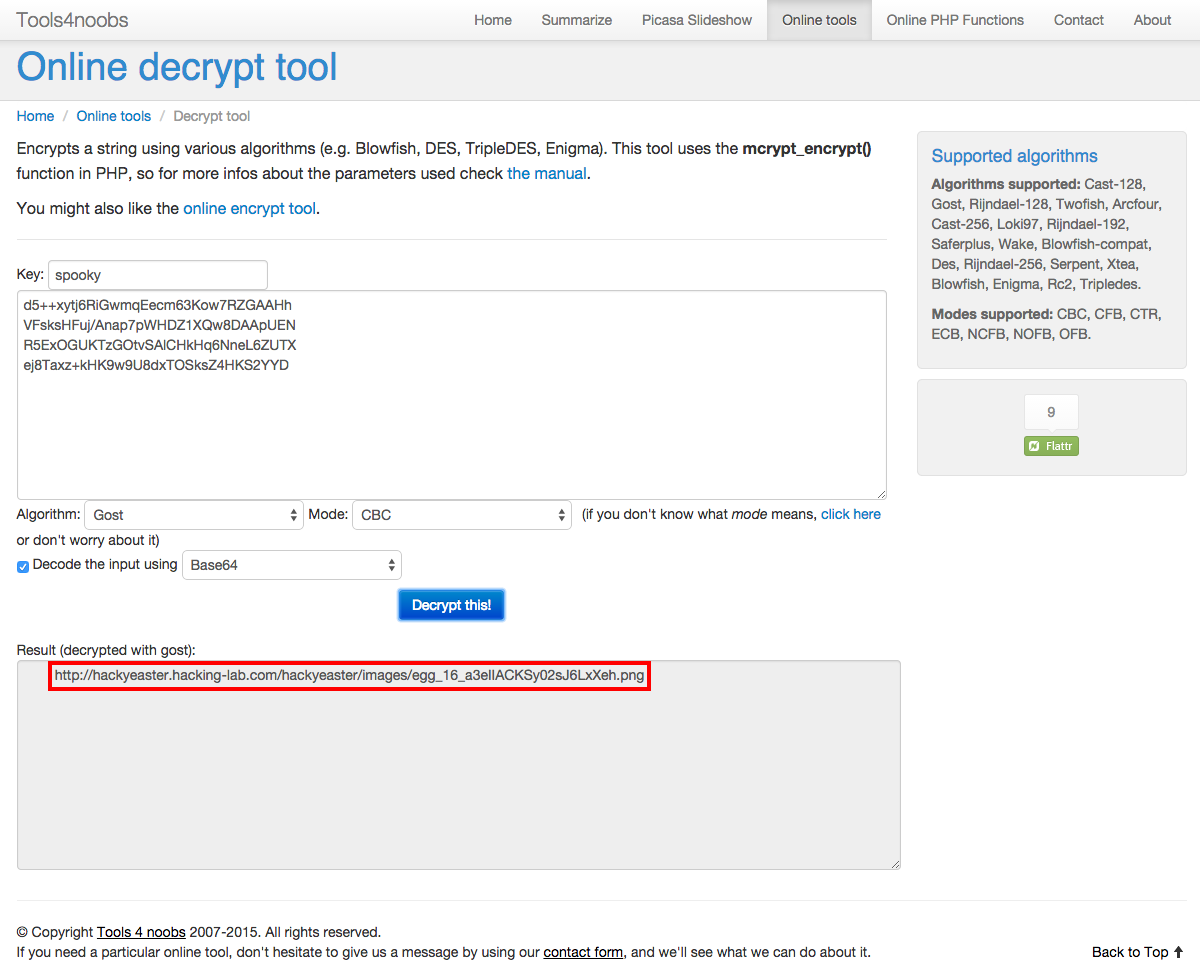
#!/usr/bin/env php
<?
$key = "spooky"; while(strlen($key)<32) {$key.="\0";}
$ciphertxt = "d5++xytj6RiGwmqEecm63Kow7RZGAAHhVFsksHFuj/Anap7pWHDZ1XQw8DAApUENR5ExOGUKTzGOtvSAlCHkHq6NneL6ZUTXej8Taxz+kHK9w9U8dxTOSksZ4HKS2YYD";
$ciphertxt_b64 = base64_decode($ciphertxt);
$iv_size = mcrypt_get_iv_size(MCRYPT_GOST, MCRYPT_MODE_CBC);
$iv = ""; while(strlen($iv)<$iv_size) {$iv.="\0";}
$plaintxt = mcrypt_decrypt(MCRYPT_GOST, $key, $ciphertxt_b64, MCRYPT_MODE_CBC, $iv);
echo "key: $key".PHP_EOL;
echo "ciphertxt: $ciphertxt".PHP_EOL;
echo "plaintxt: $plaintxt".PHP_EOL;
?>
http://hackyeaster.hacking-lab.com/hackyeaster/images/egg_16_a3eIIACKSy02sJ6LxXeh.pngSharpen your eyes, and diff 2 img below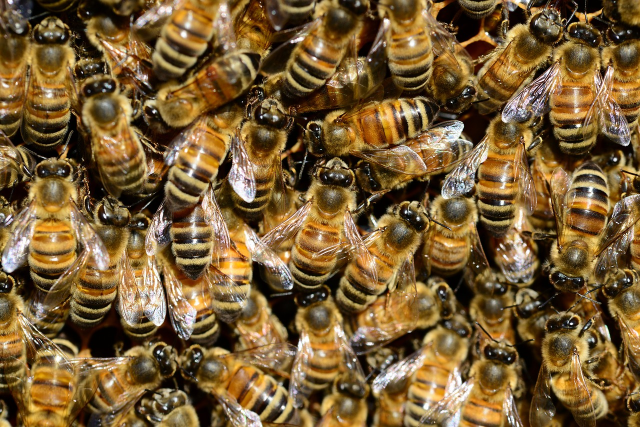
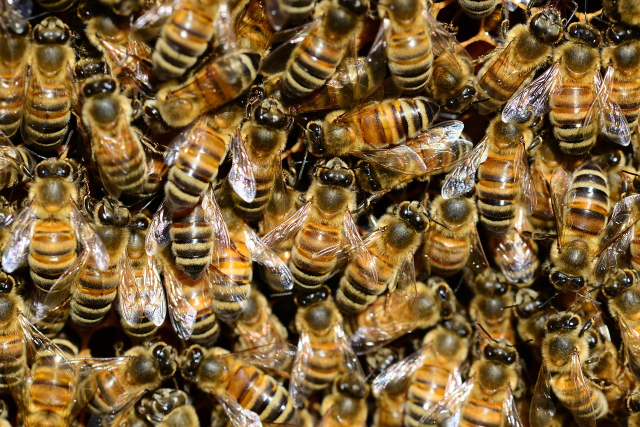
pix @ corresponding pos match = 0 ie. RGB(0,0,0) = black,pix @ corresponding pos mismatch = 1 ie. RGB(255,255,255) = white#!/usr/bin/env python
#-*- coding: utf-8 -*-
import sys
import codecs
import operator
import numpy as np
from PIL import Image, ImageFilter
def mk_agent_xor():
im1 = Image.open("img/difference1.bmp").convert("RGB")
#np.asarray(im1)
pix1s = im1.load()
im2 = Image.open("img/difference2.bmp").convert("RGB")
pix2s = im2.load()
w1, h1 = im1.size
for y in xrange(h1):
for x in xrange(w1):
pix1 = pix1s[x,y]
pix2 = pix2s[x,y]
if pix1 != pix2:
pix1s[x,y] = (255,255,255)
else:
pix1s[x,y] = (0,0,0)
im1.save("difference0.bmp")

 w/ target
w/ target  , each found on one side of Agent's glasses, yields
, each found on one side of Agent's glasses, yields 
#!/usr/bin/env python
#-*- coding: utf-8 -*-
import sys
import codecs
import operator
import numpy as np
from PIL import Image, ImageFilter
def crop_agent_xor():
im = Image.open("difference0.bmp").convert("RGB")
#qr#
left, top, right, bottom = 245, 140, 280, 175
img = im.crop((left, top, right, bottom))
#img = im.filter(ImageFilter.{BLUR,CONTOUR,DETAIL,EDGE_ENHANCE,EDGE_ENHANCE_MORE,EMBOSS,FIND_EDGES,SMOOTH,SMOOTH_MORE,SHARPEN})
#img.thumbnail(sz)
#img.show()
img.save("img/lvl17-qr1.jpg")
#tgt#
left, top, right, bottom = 333, 140, 368, 175
img = im.crop((left, top, right, bottom))
img.save("img/lvl17-qr2.jpg")
def mk_qr_code():
im1 = Image.open("img/lvl17-qr1.jpg").convert("RGB")
#im1.getcolors(), im1.format, im1.size, im1.mode
im2 = Image.open("img/lvl17-qr2.jpg").convert("RGB")
pix2s = list(im2.getdata())
w2, h2 = im2.size
pix2s = [pix2s[i*w2:(i+1)*w2] for i in xrange(h2)]
pix1s = im1.load()
w1, h1 = im1.size
for y in xrange(h1):
for x in xrange(w1):
pix1 = pix1s[x,y]
pix2 = pix2s[x][y]
pix = []
for ci in xrange(len(pix1)):
pix.append(pix1[ci] ^ pix2[ci])
pix1s[x,y] = tuple(pix)
im1.save("img/lvl17-qr.jpg")
In this challenge, you need to get access to a website Inspect sharks.pcapng, in order to get the credentials needed
tcp stream eq 310.11.0.52:62046 → 10.11.0.48:8080
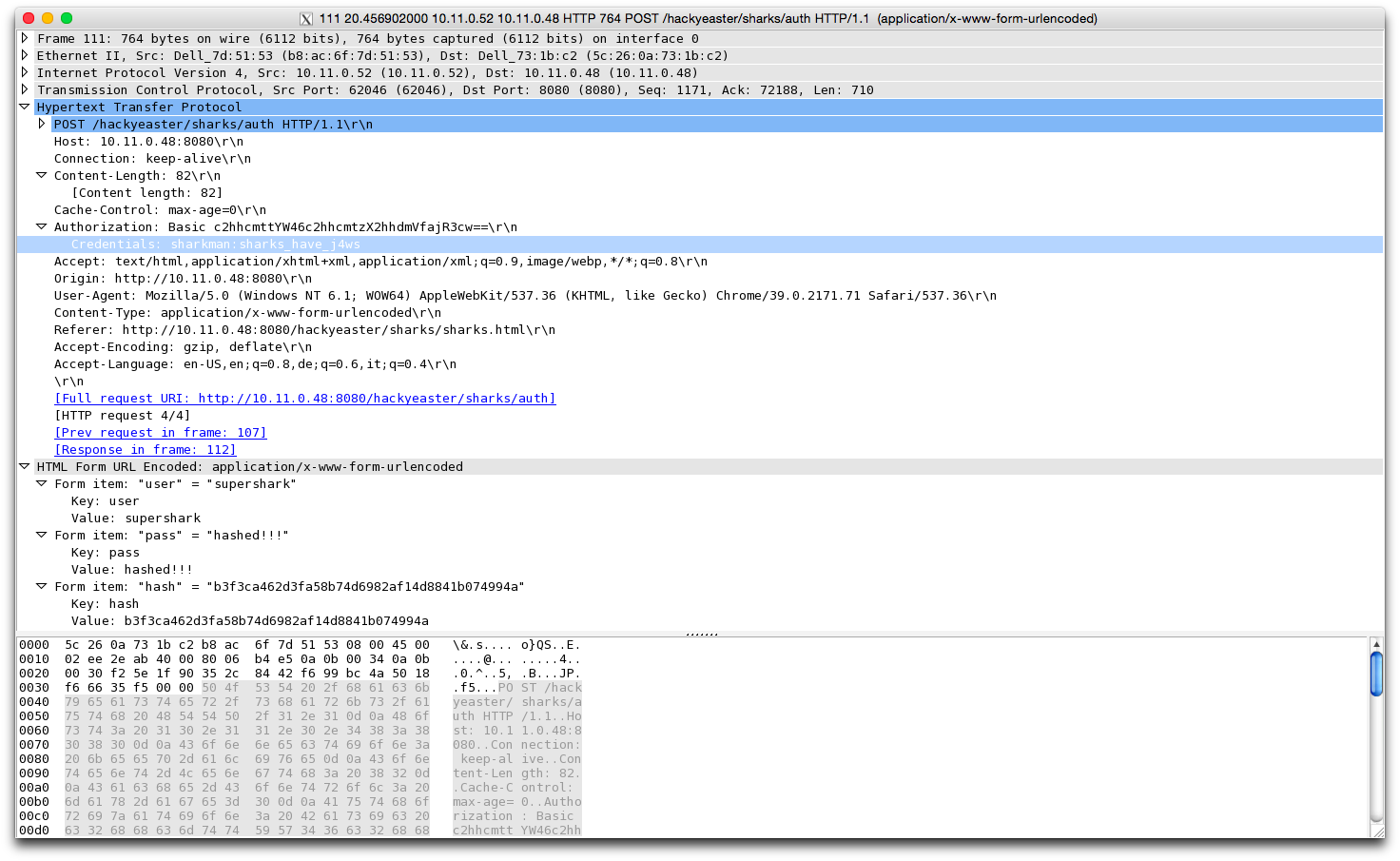
sharkman:sharks_have_j4wscurl -sL -u sharkman:sharks_have_j4ws -H "Authorization: Basic c2hhcmttYW46c2hhcmtzX2hhdmVfajR3cw==" -X POST "http://hackyeaster.hacking-lab.com/hackyeaster/sharks/auth" -d "user=supershark&pass=hashed%21%21%21&hash=b3f3ca462d3fa58b74d6982af14d8841b074994a"…
<body>
<div class="title">Sharks on Wire</div>
<div class="imageBg">
<img src="egg_18_j9rU8ma6nBfz986gJZmf.png" class="image"/>
</div>
</body>
…
curl -sL -u sharkman:sharks_have_j4ws -H "Authorization: Basic c2hhcmttYW46c2hhcmtzX2hhdmVfajR3cw==" "http://hackyeaster.hacking-lab.com/hackyeaster/sharks/egg_18_j9rU8ma6nBfz986gJZmf.png" -o egg_18_j9rU8ma6nBfz986gJZmf.pngTime for paper and scissors! The PDF contains some paper strips. Your task is to combine them in such a way that a passphrase appears Hint: The passphrase does *not* use all characters available, and it has no spaces
#!/usr/bin/env python
#-*- coding: utf-8 -*-
import sys
import codecs
import string
import itertools
from functools32 import lru_cache
def gen_wordlst(charset, maxlen):
files = {}
for letter in charset:
files[letter] = open("c19-wordlist%d-%c"%(maxlen,letter), "w")
for w in itertools.product(charset, repeat=maxlen):
print>>files[w[0]], "".join(w)
for v in files.values():
if v:
print>>sys.stderr, "=>", v.name
v.close()
horzs = ["s.a.e", "eldpr", "qt.ia", "pupar", "ny.hs"]
verts = ["lr.se", "epdke", ".por.", ".sob.", "ahmed"]
def mkstrip(is_horz=True, mode=1):
strips = []
for p in itertools.permutations(horzs if is_horz else verts):
pp = [["" for x in xrange(5)] for x in xrange(5)]
for i,s in enumerate(p):
for j,c in enumerate(s):
if is_horz:
pp[i][j] = c
else: #vert
pp[j][i] = c
if mode == 1:
pp = ["".join(p) for p in pp]
else:
pp = "".join("".join(p) for p in pp)
strips.append(pp)
return strips
def perm_horz(width=5):
"""permute horizontal strips to form grid
width: # grids to layout on same line
"""
strips = mkstrip(is_horz=True, mode=1)
for i in xrange(0,len(strips),width):
hh = []
for j in xrange(len(strips[i])):
hh = []
for k in xrange(width):
if i+k < len(strips):
hh.append(strips[i+k][j])
print "\t".join(hh).replace(".", " ")
print
def perm_vert(width=5):
"""permute vertical strips to form grid
width: # grids to layout on same line
"""
strips = mkstrip(is_horz=False, mode=1)
for i in xrange(0,len(strips),width):
vv = []
for j in xrange(len(strips[i])):
vv = []
for k in xrange(width):
if i+k < len(strips):
vv.append(strips[i+k][j])
print "\t".join(vv).replace(".", " ")
print
@lru_cache(maxsize=None)
def align_build(a,b,c,s):
""" recursively build all possible valid str
from given a,b
"""
if c == min(len(a),len(b)): return s
ss = []
if a[c] != ".":
r = align_build(a,b,c+1,""+s+a[c])
if r: ss.append(r)
if b[c] != ".":
r = align_build(a,b,c+1,""+s+b[c])
if r: ss.append(r)
return "\n".join(ss)
def align(idx):
""" gen str by align-merge horz+vert strip
from cartesian pdt of horz + vert strips
- simulate overlap of horz + vert strips
"""
horzd = mkstrip(is_horz=True, mode=2)
vertd = mkstrip(is_horz=False, mode=2)
# print "|horzd|=", len(horzd), ";|vertd|=", len(vertd) #120
# for hs in horzd: print "".join(hs).replace(".", " ")
# print
# for vs in vertd: print "".join(vs).replace(".", " ")
for i,ab in enumerate(itertools.product(horzd, vertd)):
if i == int(idx): #idx((a,b))
a, b = ab
res = align_build(a,b,0,"")
if len(res) > 0:
print "".join(res)
break
if __name__ == "__main__":
# gen_wordlst("abdehiklmnopqrstuy", 5)
# perm_horz()
# perm_vert()
idx = 10290 #paperstripsmadebyshredder found @ this idx
if len(sys.argv)>1: idx = int(sys.argv[1])
align(idx)
echo paperstripsmadebyshredder | python -m wordsegmentpapers trips made by shredderpaper strips made by shredder"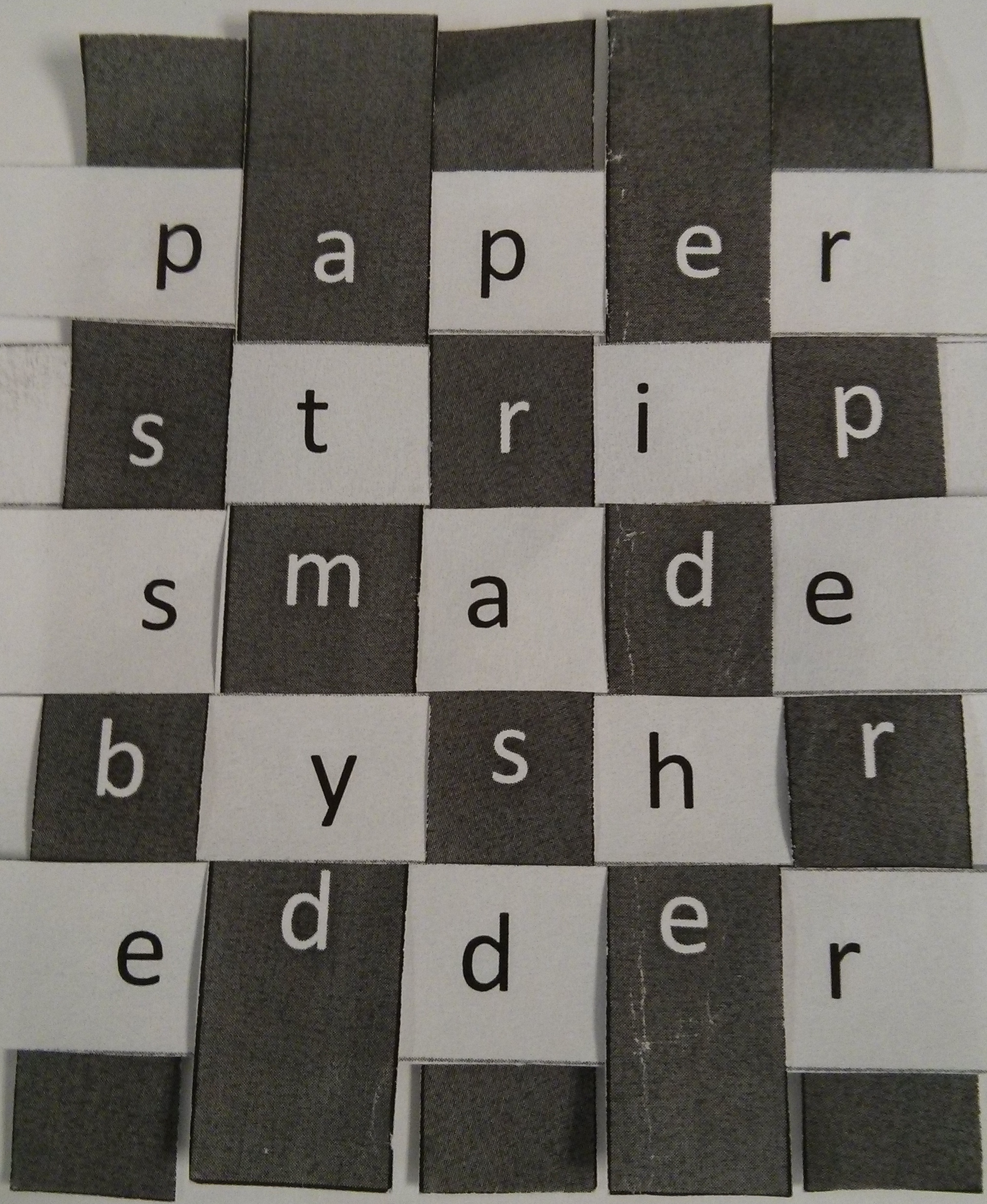
paperstripsmadebyshredderRobots have placed an egg on this web server. If you wanna find it, you need to think and act like a bot
User-agent: EasterBot Disallow: / Allow: /hackyeaster/bots/bots. User-agent: * Disallow: /
{"User-agent": "EasterBot"}
curl -sL -A "EasterBot" "http://hackyeaster.hacking-lab.com/hackyeaster/bots/bots.html"
<html>
<head><title>Bots</title>
<script type="text/javascript">
/**
// @ http://matthewfl.com/unPacker.html
if (!(navigator.userAgent === 'EasterBot'))
{
location.replace('http://en.wikipedia.org/wiki/C-3PO');
}
*/
eval(String.fromCharCode(105, 102, 32, 40, 33, 40, 110, 97, 118, 105, 103, 97, 116, 111, 114, 46, 117, 115, 101, 114, 65, 103, 101, 110, 116, 32, 61, 61, 61, 32, 39, 69, 97, 115, 116, 101, 114, 66, 111, 116, 39, 41, 41, 32, 123, 32, 108, 111, 99, 97, 116, 105, 111, 110, 46, 114, 101, 112, 108, 97, 99, 101, 40, 39, 104, 116, 116, 112, 58, 47, 47, 101, 110, 46, 119, 105, 107, 105, 112, 101, 100, 105, 97, 46, 111, 114, 103, 47, 119, 105, 107, 105, 47, 67, 45, 51, 80, 79, 39, 41, 59, 125));</script></head>
<body style="background: white; border: 20px solid white;">
<div style="width: 100%; height: 100%; background: url('./robotbg.jpg') no-repeat center center fixed; -webkit-background-size: contain; -moz-background-size: contain; -o-background-size: contain; background-size: contain;"> </div>
</body></html>

for w in bama waboki pisal fatatu fomu wosebi seju sowu seju bamas mufe wafub fomu mowewe; do egrep "^${w}\b" file/roila-wordlist.txt; done | cut -f2 | tr '\n' ' 'you must make word of addition two and two this be name of pagefour.html{"User-agent": "EasterBot"}
curl -sL -A "EasterBot" "http://hackyeaster.hacking-lab.com/hackyeaster/bots/four.html"
<html>
<head>
<title>Bots</title>
<meta name="description" content="Robots talk in ROILA language: eman egap eht esrever tsum">
<meta name="keywords" content="secret, page, robots, fun, hacky easter, blrt, five, beep">
…
</head>
<body style="background: white; border: 20px solid white;">
<div style="width: 100%; height: 100%; background: url('./robotbg2.jpg') no-repeat center center fixed; -webkit-background-size: contain; -moz-background-size: contain; -o-background-size: contain; background-size: contain;"> </div>
</body>
</html>

MeTA (hint), together with attr:content of <meta name="description">: eman egap eht esrever tsumecho -ne "eman egap eht esrever tsum" | rev yields: must reverse the page name…
<body style="background: white; border: 20px solid white;">
<div style="position: absolute; left:50%; top: 50%; margin-left: -187px; margin-top: -187px; width: 375px; height: 375px; background: url('./egg_20_j5fir8U6g8.png'); background-size: 375px 375px; background-repeat: no-repeat;"> </div>
</body>
</html>
Tired of boring QR codes, Dr. Bunny C. Easter developed an alternative. He's proudly introducing the "Cony Code" now! Crack the code in order to get another easter egg! Hint:110is blue, the rest's up to you...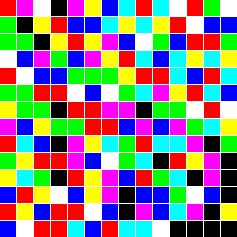
#!/usr/bin/env python
#-*- coding: utf-8 -*-
import sys
import codecs
from PIL import Image, ImageFilter
reduced = []
im1 = Image.open("img/conycode.png").convert("RGB")
pix1s = im1.load()
w1, h1 = im1.size
for y in xrange(8,h1,17):
xyc = []
for x in xrange(8,w1,17):
pix1 = pix1s[x,y]
xyc.append((x,y,pix1))
reduced.append(xyc)
ans = ""
for r in reduced:
for xyc in r:
_, _, pix1 = xyc
ans += "".join(map(lambda c: "1" if c==0 else "0", list(pix1)))
print "".join(chr(int(ans[i:i+8], 2)) for i in xrange(0,len(ans),8))
prove your skills in hash cracking:
raLu6+eAmFelf2/uSy/67iTq57E=

digits {0,1,7,9} are marked; assume this is charset
hash: ada2eeebe7809857a57f6fee4b2ffaee24eae7b1
txt: 1199019170177790
a791KNndKVmnr7N4mEJfZ1VfZ/Z3mHyufoYhCiyKDb38JI7C17JAEPRAutwiI7S1

name of song by Rick Astley
hash: 6bbf7528d9dd2959a7afb37898425f67555f67f677987cae7e86210a2c8a0dbdfc248ec2d7b24010f440badc2223b4b5
txt: hopelessly
uAgUxeDzhrBjcWP9iv6pKQ==

hash: b80814c5e0f386b0637163fd8afea929
txt: Disc0very.5
l5HL4K6RmgMwmUota6Jrjww6HaFcc7zl/KOUlYgabJA=

hash: 9791cbe0ae919a0330994a2d6ba26b8f0c3a1da15c73bce5fca39495881a6c90
txt: enginebulbgoatimportant
#!/usr/bin/env python
#-*- coding: utf-8 -*-
import os #os.linesep
import sys
import codecs
import hashlib
import base64
import itertools
import random
import string
import binascii
def hmatch(txt, hash):
def name_of(var):
import inspect
callers_local_vars = inspect.currentframe()\
.f_back.f_locals.items()
return [var_name \
for var_name, var_val in callers_local_vars \
if var_val is var][0]
hash = hash.lower()
md5 = hashlib.md5(txt).hexdigest()
sha1 = hashlib.sha1(txt).hexdigest()
sha224 = hashlib.sha224(txt).hexdigest()
sha256 = hashlib.sha256(txt).hexdigest()
sha384 = hashlib.sha384(txt).hexdigest()
sha512 = hashlib.sha512(txt).hexdigest()
hashes = [md5,sha1,sha224,sha256,sha384,sha512]
hnames = map(name_of, hashes)
hashes = map(str.lower, hashes)
if hash in hashes:
i = hashes.index(hash)
print "\n".join([
"txt: %s [%d]"%(txt,len(txt)),
"%s: %s [%d]"%(hnames[i],hashes[i],len(hashes[i]))
])
return True
return False
if __name__ == "__main__":
def h(hash):
#binascii.hexlify(base64.b64decode(hash))
return base64.b64decode(hash).encode("hex")
hash1 = h("raLu6+eAmFelf2/uSy/67iTq57E=")
hash2 = h("a791KNndKVmnr7N4mEJfZ1VfZ/Z3mHyufoYhCiyKDb38JI7C17JAEPRAutwiI7S1")
hash3 = h("uAgUxeDzhrBjcWP9iv6pKQ==")
hash4 = h("l5HL4K6RmgMwmUota6Jrjww6HaFcc7zl/KOUlYgabJA=")
for i, hash in enumerate([hash1, hash2, hash3, hash4]):
print>>sys.stderr, "#%d:"%(i+1), hash
### Hash 1 ###
charset, maxlen = [0,1,7,9], 16
def h1_rand(charset, maxlen):
return "".join(["%d"%random.choice([charset]) \
for i in xrange(maxlen)])
def h1_iter(w, charset, maxlen, hash):
if len(w) == maxlen:
return hmatch(hash, w)
for c in charset:
if h1_iter(w+str(c), charset, maxlen, hash):
break
h1_iter("", charset, maxlen, hash1)
txt = h1_rand(charset, maxlen)
while not hmatch(txt, hash1):
txt = h1_rand(charset, maxlen)
### Hash 3 ###
intab, outtab = "aegiost", "4361057" #leetspeak
leet = string.maketrans(intab, outtab)
with open("file/lvl22-wordlist.txt") as f:
words = map(string.strip, f.readlines())
while True:
word = list(random.choice(words))
def cfind(s, ch):
return [i for i,ltr in enumerate(s) if ltr==ch]
possible = []
for c in intab:
possible.extend(cfind(word, c))
if possible == []: continue
idx = random.choice(possible)
used = set()
used.add(idx)
word[idx] = word[idx].translate(leet)
idx = random.randint(0, len(word)-1)
while idx in used:
idx = random.randint(0, len(word)-1)
used.add(idx)
word[idx] = word[idx].upper()
punct = random.choice(string.punctuation)
digit = random.choice(string.digits)
txt = "".join(word)+punct+digit
if hmatch(txt, hash3): sys.exit()
Did you beat the Swordmaster in Monkey Island? Even if, it ain't gonna help you this time. Get to know the mighty Nerd Master! Connect to hackyeaster.hacking-lab.com:1400, and start the battle. Here's an insult to start with: Go 127.0.0.1 to your mummy.
#!/usr/bin/env python
#-*- coding: utf-8 -*-
import os #os.linesep
import sys
import codecs
import json
import telnetlib
import hashlib
from random import randint
def find_answer(question, data):
for entry in data:
if entry["question"] == question:
return entry["answer"].encode("utf-8")
data.append({"question": question, "answer": ""})
return ""
def ask_question(data):
for entry in data:
if entry["answer"] == "":
return entry["question"].encode("utf-8")
return data[randint(0,len(data)-1)]["question"].encode("utf-8")
def add_answer(question, answer, data):
for entry in data:
if entry["question"] == question:
entry["answer"] = answer
return
def show(data):
for entry in data:
print>>sys.stderr, u"Q: %s; A: %s" \
%(entry["question"], entry["answer"])
if __name__ == "__main__":
filepath = u"challenge23.json"
with open(filepath) as file:
data = json.load(file)
host, port = "hackyeaster.hacking-lab.com", 1400
nr = "\r\n"
tn = telnetlib.Telnet(host, port)
tn.read_until("Do you feel brave enough to challenge the mighty nerdmaster? (y|n)")
tn.write("y" + nr)
tn.read_until("---- YOUR TURN ----\n")
while True:
try:
my_question = ask_question(data)
tn.write(my_question + nr)
print "I ask: " + my_question
answer = tn.read_until("---- MY TURN ----\n").split("\n")[0]
print "It Answered: " + answer
if answer != "We've had this one before.":
add_answer(my_question, answer, data)
print
print "---- MY TURN ----"
print
question = tn.read_until("\n").split("\n")
print "It asked: " + question[0]
my_answer = find_answer(question[0], data)
tn.write(my_answer + nr)
print "I answer: " + my_answer
response = tn.read_until("---- YOUR TURN ----\n")
print "resp:", response
except EOFError as e:
print ">> Connection closed"
break
with open(filepath, "w") as outfile:
json.dump(data, outfile)
print "%s updated"%filepath
BUF_SIZE = 65536 #64KB chunk
sha1 = hashlib.sha1()
with open(filepath, "rb") as f:
while True:
data = f.read(BUF_SIZE)
if not data: break
sha1.update(data)
print "sha1sum({}): {}".format(filepath, sha1.hexdigest())
question: "Go 127.0.0.1 to your mummy."
answer: "Won't work. I only support IPv6."
question: "Pna lbh ernq guvf?"
answer: "EBG13 vf sbe ynzref."
question: "Tell me your name, hobo. I need to check your records."
answer: "My name is bob'; DROP TABLE VALJ;--"
question: "You'll be 0xdeadbeef soon."
answer: "Not as long as I have my 0xcafebabe."
question: "After loosing to me, your life won't be the same anymore."
answer: "A Life? Cool! Where can I download one of those?"
question: "You must be jealous when seeing my phone's display."
answer: "Not really - Your pixels are so big, some of them have their own region code!"
question: "You're so slow, you must have been written in BASIC."
answer: "At least I don't have memory leaks like you."
question: "Ping! Anybody there?"
answer: "ICMP type 3, code 13: Communication Administratively Prohibited"
question: "This fight is like a hash function - it works in one direction only."
answer: "Too bad you picked LM hashing."
question: "You should leave your cave and socialize a bit."
answer: "I'm not anti-social. I'm just not user friendly."
question: "1f u c4n r34d th1s u r s70p1d."
answer: "You better check your spelling. Stoopid has two 'o's."
question: "I have more friends than you."
answer: "Yeah, but only until you update your Facebook profile with a real picture of you!"
question: "Af7ter th1s f1gh7, I w1ll pwn ur b0x3n."
answer: "Check your settings - you seem to have chosen the Klingon keyboard layout."
question: "format C:"
answer: "Specified drive does not exist."
question: "I bet you don't even understand binary."
answer: "Sure I do. Me and you, we are 10 different kind of persons."
question: "I'll check you out - any last words?"
answer: "svn:ignore"
Respect! you've beaten the mighty nerd master! Here's your egg:
http://hackyeaster.hacking-lab.com/hackyeaster/images/egg_23_j7vzfUzftszdf754fXDS.png
Crypto Chiefs Ltd. developed a new hash function, which takes a 'divide and conquer' approach and combines several well-known hash functions ("Split, Hash, And Merge"). The inventors claim that with this approach, their function becomes more secure. Can you prove they are wrong?
Create a string which produces the following hash:
757c479895d6845b2b0530cd9a2b11
spec: shamhash.pdf
#!/usr/bin/env python
#-*- coding: utf-8 -*-
import sys
import codecs
import itertools
import hashlib
from hashlib import sha1, sha256, sha512
from Crypto.Hash import MD2, MD5
if __name__ == "__main__":
ans = "afpmqtaaqidtaww8ntangecaaf9pt3"
charset = "abcdefghijklmnopqrstuvwxyz0123456789"
begin, end = 0, 6
hashes = [(MD2, "757c47"), (MD5, "9895d6"), (sha1, "845b2b"), (sha256, "0530cd"), (sha512, "9a2b11")]
for algo, frag in hashes:
if algo in [MD2, MD5]:
begin += 6
end += 6
continue
print>>sys.stderr, algo.__name__
for i in itertools.product(charset, repeat=6):
word = "".join(i)
try: whash = algo.new(word).hexdigest()
except AttributeError:
m = algo()
m.update(word)
whash = m.hexdigest()
if frag == whash[begin:end]:
print word, whash
ans += word
break
begin += 6
end += 6
print "ans:", ans
ans → redirect to http://hackyeaster.hacking-lab.com/hackyeaster/sham_m7f3ngUfg6LLzf530zub.htmljadandida.zip
JAD: ref. JAva DecompilerIDA: ref. Interactive DisAssemblerlib/libhe2015_Lizzle.dll::LizzleDLL::{Fizzle,Shizzle} loaded & used{bizzle,rizzle}main method
kk = fizzle(rizzle(shizzle(bizzle(k))))s3cr3t.bin (assumes this is/contains egg w/ QR code) successfully decrypt()-ed if result "v3O] pmWm<Y(0=21".equals(k).class files → .java source codeString bizzle(String s) case-sensitively increments char w/ wrap-around, ie. tr "a-yzA-YZ" "b-zaB-ZA"
String rizzle(String s) swaps case of all letters in s, ie. tr "[:upper:][:lower:]" "[:lower:][:upper:]"size_t Shizzle(char *a1, char *a2) reverses a1 → a2, iff #a1 == 16 charssize_t Fizzle(char *a1, char *a2) performs char transformation in printable ASCII range on a1, then swaps halves of result, producing a2/*Java*/
String bizzle(String s)
{
char[] chars = s.toCharArray();
for(int i = 0; i < chars.length; i++)
{
char c = chars[i];
if((c >= 'a') && (c < 'z'))
{
c = (char)(c + '\001');
}
else if(c == 'z')
{
c = 'a';
}
else if((c >= 'A') && (c < 'Z'))
{
c = (char)(c + '\001');
}
else if(c == 'Z')
{
c = 'A';
}
chars[i] = c;
}
return new String(chars);
}
String rizzle(String s)
{
char[] chars = s.toCharArray();
for(int i = 0; i < chars.length; i++)
{
char c = chars[i];
if(Character.isUpperCase(c))
{
chars[i] = Character.toLowerCase(c);
}
else if(Character.isLowerCase(c))
{
chars[i] = Character.toUpperCase(c);
}
}
return new String(chars);
}
/*DLL*/
size_t Fizzle(char *a1, char *a2)
{
size_t result; // eax@1
int v3; // ecx@3
int v4; // eax@5
int v5; // edx@8
int v6; // edx@8
char v7; // al@10
char v8; // dl@10
char v9; // al@10
char v10; // dl@10
char v11; // al@10
char v12; // dl@10
char v13; // al@10
char v14; // dl@10
char v15; // al@10
char v16; // dl@10
char v17; // al@10
char v18; // dl@10
char v19; // al@10
char v20; // dl@10
result = strlen(a1);
if ( result == 16 )
{
v3 = 0;
do
{
while ( 1 )
{
v4 = a1[v3];
if ( (int)(v4 - 32) > 'Z' )
break;
a2[v3] = (v4 + v3 * v3 - 27) % 91 + 32;
++v3;
if ( v3 == 16 )
goto LABEL_7;
}
a2[v3++] = v4;
}
while ( v3 != 16 );
LABEL_7:
if ( a2 & 3 )
{
v7 = a2[8];
a2[8] = a2;
v8 = a2[1];
a2 = v7;
v9 = a2[9];
a2[9] = v8;
v10 = a2[2];
a2[1] = v9;
v11 = a2[10];
a2[10] = v10;
v12 = a2[3];
a2[2] = v11;
v13 = a2[11];
a2[11] = v12;
v14 = a2[4];
a2[3] = v13;
v15 = a2[12];
a2[12] = v14;
v16 = a2[5];
a2[4] = v15;
v17 = a2[13];
a2[13] = v16;
v18 = a2[6];
a2[5] = v17;
v19 = a2[14];
a2[14] = v18;
v20 = a2[7];
a2[6] = v19;
result = a2[15];
a2[15] = v20;
a2[7] = result;
}
else
{
v5 = a2[8];
a2[8] = a2;
result = a2[4];
a2 = v5;
v6 = a2[12];
a2[12] = result;
a2[4] = v6;
}
a2[16] = 0;
}
else
{
a2 = 0;
}
return result;
}
size_t Shizzle(char *a1, char *a2)
{
size_t result;
result = strlen(a1);
if ( result == 16 )
{
a2[15] = *a1;
a2[14] = a1[1];
a2[13] = a1[2];
a2[12] = a1[3];
a2[11] = a1[4];
a2[10] = a1[5];
a2[9] = a1[6];
a2[8] = a1[7];
a2[7] = a1[8];
a2[6] = a1[9];
a2[5] = a1[10];
a2[4] = a1[11];
a2[3] = a1[12];
a2[2] = a1[13];
a2[1] = a1[14];
result = a1[15];
a2[16] = 0;
a2 = result;
}
else
{
a2 = 0;
}
return result;
}
#!/usr/bin/env python
#-*- coding: utf-8 -*-
import sys
import codecs
import string
sys.stdout = codecs.getwriter("utf8")(sys.stdout)
sys.stderr = codecs.getwriter("utf8")(sys.stderr)
def unfizzle_undo(c, idx):
c = ord(c)
c -= 32
n = 0
while True:
cc = c + n * 91 + (27 - (idx * idx))
if 32 <= cc <= 122: break
n += 1
c = cc
c = chr(c)
return c
def unfizzle(s):
ss = list(s)
ss[:8], ss[8:] = ss[8:], ss[:8]
for i in xrange(15,-1,-1):
ch = ss[i]
if ord(ch) > ord("z"): continue
else: ss[i] = unfizzle_undo(ch, i)
return "".join(ss)
def unrizzle(s):
ret = []
for c in s:
if c in string.ascii_letters:
if c.isupper(): ret.append(c.lower())
elif c.islower(): ret.append(c.upper())
else: ret.append(c)
return "".join(ret)
def unshizzle(s): return s[::-1]
def unbizzle(s):
ret = []
for c in s:
added = False
for lst in [string.ascii_lowercase, string.ascii_uppercase]:
if c in lst:
ret.append(lst[(lst.index(c)-1+len(lst))%len(lst)])
added = True
break
if not added: ret.append(c)
return "".join(ret)
if __name__ == "__main__":
k = "v3O] pmWm<Y(0=21"
for i in xrange(10):
k = unbizzle(unshizzle(unrizzle(unfizzle(k))))
print k
jadnIdal0vecod3n to original JadAndIda.class, which decrypts s3cr3t.bin → eggizzle_25.pngWelcome to Clumsy Cloud™! If your files are the eggs, then we are the hen™. We encrypt all your files, with a strong passphrase. The passphrase is kept securely in this app, protected by a PIN.
Enter your PIN to download your secret files.
----
Worried about losing your phone? Simply create a backup of your passphrase.
ovaederecumsale" or "8QeNdEdkspV6+1I77SEEEF4aWs5dl/auahJ46MMufkg="; or even "egg_26.png" reveals relevant code block
/src/src/ps/hacking/hackyeaster/android/Activity.java:…
private int a(String s, Context context)
{
try
{
SecretKeySpec secretkeyspec = new SecretKeySpec(a(s, "ovaederecumsale", 10000), "AES");
Cipher cipher = Cipher.getInstance("AES");
cipher.init(2, secretkeyspec);
String s1 = new String(cipher.doFinal(Base64.decode("8QeNdEdkspV6+1I77SEEEF4aWs5dl/auahJ46MMufkg=", 0)));
DownloadManager downloadmanager = (DownloadManager)getSystemService("download");
android.app.DownloadManager.Request request = new android.app.DownloadManager.Request(Uri.parse((new StringBuilder("http://hackyeaster.hacking-lab.com/hackyeaster/pin?p=")).append(s1).toString()));
request.setTitle("Hacky Easter");
request.setDescription("Egg Download");
request.setDestinationInExternalPublicDir(Environment.DIRECTORY_DOWNLOADS, "egg_26.png");
registerReceiver(new d(this), new IntentFilter("android.intent.action.DOWNLOAD_COMPLETE"));
downloadmanager.enqueue(request);
Toast.makeText(context, "Download started", 0).show();
}
catch (Exception exception)
{
return 1;
}
return 0;
}
…
public static byte[] a(String s, String s1, int i1)
{
MessageDigest messagedigest = MessageDigest.getInstance("SHA1");
byte abyte0[] = (new StringBuilder(String.valueOf(s1))).append(s).toString().getBytes();
int j1 = 0;
do
{
if (j1 >= i1)
{
byte abyte1[] = new byte[16];
System.arraycopy(abyte0, 0, abyte1, 0, 15);
return abyte1;
}
abyte0 = messagedigest.digest(abyte0);
j1++;
} while (true);
}
…
public static byte[] a(String s, String s1, int i1) == hashing routine;
private int a(String s, Context context) performs decryption, due to 2 in cipher.init(2, secretkeyspec), using supplied PINimport java.util.Base64;
…
Base64.Decoder decoder = Base64.getDecoder();
byte[] dec64 = decoder.decode("8QeNdEdkspV6+1I77SEEEF4aWs5dl/auahJ46MMufkg=");
String s1 = new String(cipher.doFinal(dec64));
…
import java.util.Base64;
…
for(int i=0; i<9999; i++)
{
String PIN = String.format("%04d", i);
String ciphertxt = crypt(PIN);
if (ciphertxt != null
&& ciphertxt.matches("^\\p{ASCII}*$"))
{
System.out.println(PIN+": "+ciphertxt);
break;
}
}
…
7113, linked to passwd=wirestarter54321
You intercepted messages exchanged by evil Dr. Hopper and his agents. They used a One Time Pad for achieving perfect secrecy. Lucky for you, they have miserably failed, since the same key was used multiple times
Check out the ciphertexts, and try to decrypt them
Hint: The plaintexts consist of lowercase letters and spaces only
60c46964f83879618e2878de539f6f4a6271d716
63c37a6ca177792092602cc553c9684b
68d82c6bf4767f79dd617f9642d768057f63c1
6c8a7b6ce06a3161dd6a60d755d42d4d6d67
71c26929e96931698e2865d816d3624b687cd6
6cda6d6df87764709c6c7bd357d361556d77
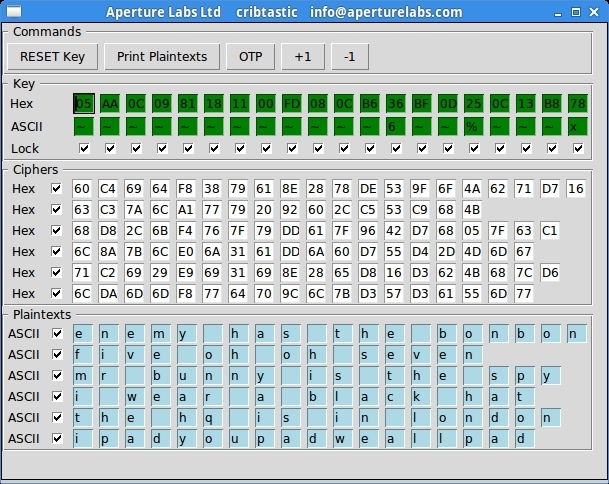
05aa0c0981181100fd080cb636bf0d250c13b878enemy has the bonbon five oh oh seven mr bunny is the spy i wear a black hat the hq is in london ipadyoupadweallpad
